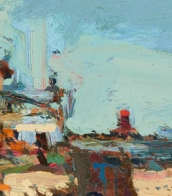Guatemala — Auction price

Alfred Jensen was an American abstract painter associated with the Abstract Expressionist movement. Jensen's work often incorporated complex systems of symbols and numerals, which he believed could be used to represent the structure of the universe.
Jensen spent much of his childhood in Europe before immigrating to the United States in the 1920s. He studied at the Art Students League in New York and began his career as an artist in the 1930s, creating figurative paintings that were influenced by the work of Picasso and other European modernists.
In the 1950s and 1960s, Jensen began exploring abstraction and began incorporating his interest in numerology and symbolism into his work. He developed a complex system of symbols and numerals, which he believed could be used to represent the underlying structure of the universe. His paintings often featured grids, mandalas, and other geometric forms, and he believed that his art could serve as a kind of visual language that could help unlock the mysteries of the universe.
Jensen's work was exhibited widely in the United States and Europe, and he was the recipient of several awards and honors throughout his career.
Jensen's unique approach to abstraction and his interest in numerology and symbolism have made him an important figure in the development of abstract painting in the mid-20th century.


Alfred Jensen was an American abstract painter associated with the Abstract Expressionist movement. Jensen's work often incorporated complex systems of symbols and numerals, which he believed could be used to represent the structure of the universe.
Jensen spent much of his childhood in Europe before immigrating to the United States in the 1920s. He studied at the Art Students League in New York and began his career as an artist in the 1930s, creating figurative paintings that were influenced by the work of Picasso and other European modernists.
In the 1950s and 1960s, Jensen began exploring abstraction and began incorporating his interest in numerology and symbolism into his work. He developed a complex system of symbols and numerals, which he believed could be used to represent the underlying structure of the universe. His paintings often featured grids, mandalas, and other geometric forms, and he believed that his art could serve as a kind of visual language that could help unlock the mysteries of the universe.
Jensen's work was exhibited widely in the United States and Europe, and he was the recipient of several awards and honors throughout his career.
Jensen's unique approach to abstraction and his interest in numerology and symbolism have made him an important figure in the development of abstract painting in the mid-20th century.


Alfred Jensen was an American abstract painter associated with the Abstract Expressionist movement. Jensen's work often incorporated complex systems of symbols and numerals, which he believed could be used to represent the structure of the universe.
Jensen spent much of his childhood in Europe before immigrating to the United States in the 1920s. He studied at the Art Students League in New York and began his career as an artist in the 1930s, creating figurative paintings that were influenced by the work of Picasso and other European modernists.
In the 1950s and 1960s, Jensen began exploring abstraction and began incorporating his interest in numerology and symbolism into his work. He developed a complex system of symbols and numerals, which he believed could be used to represent the underlying structure of the universe. His paintings often featured grids, mandalas, and other geometric forms, and he believed that his art could serve as a kind of visual language that could help unlock the mysteries of the universe.
Jensen's work was exhibited widely in the United States and Europe, and he was the recipient of several awards and honors throughout his career.
Jensen's unique approach to abstraction and his interest in numerology and symbolism have made him an important figure in the development of abstract painting in the mid-20th century.


























